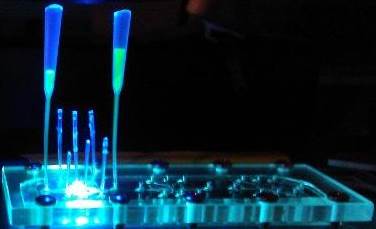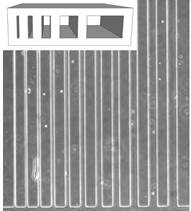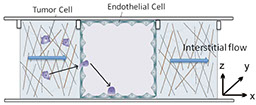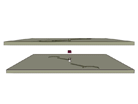Microfluidics

A contact line pinning based microfluidic device for the studies of cancer cell migration and morphology (Chih-Kuan Tung)
We have developed a contact line pinning based microfluidic to generate well-control interstitial fluid flow and study its effect on cancer cell migration and mophorlogy. READ MORE.

A microfluidic device with various surface architectures for the studies of sperm migration(Chih-Kuan Tung)
We have developed a microfluidic device etched with multiple channel sizes to study sperm migration. READ MORE.

A hydrogel-based microfluidic device for the studies of directed cell migration (Eugene Kalinin, Max Wasserman)
We have developed a hydrogel-based microfluidic device that is capable of generating a steady and long term linear chemical concentration gradient with no through flow in a microfluidic channel. READ MORE.

Directing neural stem cells using a microchemotaxis device (Daniel Rhoads, Donald Lee, and Kevin Wong)
Engraftment of neural stem cells (NSCs) to replace central nervous system cells lost to injury or disease is a promising treatment strategy. However, many regions of the adult brain shown low levels of permissiveness to NSC migration, limiting the effectiveness of both endogenous and transplanted NSC therapies. By enhancing the motility of the ‘stem cell pool’ to the site of central nervous system(CNS) injury or disease using chemical cues, treatment strategies will become more successful. READ MORE.

A Microfluidic Intravasation Model (Chih-Kuan Tung)
Growing endothelial cells on the surface of collagen matrix and side walls to form a microvessel to observe tumor cells transmigrate from ECM to endothelial tube.

Modeling a Microvessel (Andrew Darling, Chantel Lafond)
Endothelial cells readily form a monolayer upon collagen surface, so we have methods to adhere collagen to microfluidic channels, to rapidly concentrate collagen to a percentage-by-weight so that it may be molded into channels, and to form microfluidic channels out of gelatin, which is denatured collagen, treated with various agents to keep it solid at 37 degrees C.

Concentration Gradients (Andrew Darling)
Modified versions of the chemotaxis channel (see BioMEMS section) have been constructed from glutaraldehyde-processed gelatin, microbial transglutaminase-processed gelatin, and 3% collagen. These devices allow for generating concentration gradients and seeding cells in devices composed entirely of biocompatible hydrogels.

Angiogenesis Invasion Models (Andrew Darling, Chantel Lafond)
By combining PDMS channels and bulk collagen components, it is possible to create concentration gradients in collagen too soft to form microchannels independently. As endothelial cells will only invade softer compositions of collagen in vitro, these hybrid material devices are necessary for angiogenesis modeling.
Site created and maintained by Young Joon Suh

